Depositional Sedimentary Facies, Stratigraphic Control, Paleoecological Constraints, and Paleogeographic Reconstruction of Late Permian Chhidru Formation (Western Salt Range, Pakistan)
Abstract
1. Introduction
2. Geological Setting
2.1. Stratigraphy of Zaluch Gorge-Chhidru Formation
Chhidru Formation
3. Material and Methods
4. Results
4.1. Lithofacies of Chhidru Formation
- Limestone facie (CF1)
- Limestone with clays interbeds facies (CF2)
- Sandy limestone facie (CF3)
4.1.1. Limestone Facies CF1
4.1.2. Limestone Interbedded with Clays Facie CF2
4.1.3. Sandy Limestone Facies CF3
4.2. Microfacies of Chhidru Formation
- Mudstone-biomicrite facies
- Wackstone-biomicrite facies
- Wackstone-biosparite facies
- Packstone-biomicrite facies
- Packstone-biosparite facies
4.2.1. Mudstone-Biomicrite Facies
4.2.2. Wackstone-Biomicrite Facies (MF-2)
4.2.3. Wackstone-Biosparite Facies (MF-3)
4.2.4. Packstone-Biomicrite Facies (MF-4)
4.2.5. Packstone-Biosparite Facies (MF-5)
5. Discussion
5.1. Dynamic Depositional Model
5.2. Permo-Triassic Boundary
6. Conclusions
Author Contributions
Funding
Institutional Review Board Statement
Informed Consent Statement
Acknowledgments
Conflicts of Interest
References
- Awan, R.S.; Khan, A.; Liu, C.; Yang, S.; Zang, Q.; Wu, Y.; Li, G.; Iltaf, K.H.; Tahir, M.; Ali, S. Subsurface geological model of sedimentary and metasedimentary wedge from Mansehra to Battal based on gravity data, Hazara area, Pakistan. Energy Geosci. 2021, 2, 229–237. [Google Scholar] [CrossRef]
- Krishna, J. High-Resolution Intrabasinal to Inter-regional Geodynamic Chronicle During the Span of the Intra-Permian–Intra-Paleogene Mega-Sequence in and Around India on the GTM. In The Indian Mesozoic Chronicle; Springer: Berlin/Heidelberg, Germany, 2017; pp. 505–694. [Google Scholar]
- Hermann, E.; Hochuli, P.A.; Bucher, H.; Roohi, G. Uppermost Permian to Middle Triassic palynology of the Salt Range and Surghar Range, Pakistan. Rev. Palaeobot. Palynol. 2012, 169, 61–95. [Google Scholar] [CrossRef]
- Schneebeli-Hermann, E.; Bucher, H. Palynostratigraphy at the Permian-Triassic boundary of the Amb section, Salt Range, Pakistan. Palynology 2015, 39, 1–18. [Google Scholar] [CrossRef]
- Khan, M.A.; Hussain, S.R.J.; Ali, B.; Ali, S.; Khan, M.J.; Mehmood, S. Microfacies analysis and depositional setting of the late Permian Wargal limestone exposed at Nammal Gorge, Western Salt Range, Pakistan. Bahria Univ. Res. J. Earth Sci. 2017, 2, 46–51. [Google Scholar]
- Wignall, P.; Hallam, A. Griesbachian (Earliest Triassic) palaeoenvironmental changes in the Salt Range, Pakistan and southeast China and their bearing on the Permo-Triassic mass extinction. Palaeogeogr. Palaeoclimatol. Palaeoecol. 1993, 102, 215–237. [Google Scholar] [CrossRef]
- Kummel, B. Stratigraphy and paleontology of the Permian-Triassic boundary beds, Salt Range and trans-Indus ranges, West Pakistan. In Stratigraphic Boundary Problems: Permian and Triassic of West Pakistan; Casa Camino Real: Las Cruces, NM, USA, 1970; Volume 4, pp. 1–110. [Google Scholar]
- Theobald, W. Notes on geology of Salt Range. Jl. ASB 1854, 23, 651. [Google Scholar]
- Ghazi, S.; Mountney, N.P.; Butt, A.A.; Sharif, S. Stratigraphic and palaeoenvironmental framework of the Early Permian sequence in the Salt Range, Pakistan. J. Earth Syst. Sci. 2012, 121, 1239–1255. [Google Scholar] [CrossRef]
- Schneebeli-Hermann, E.; Kürschner, W.M.; Hochuli, P.A.; Bucher, H.; Ware, D.; Goudemand, N.; Roohi, G. Palynofacies analysis of the Permian–Triassic transition in the Amb section (Salt Range, Pakistan): Implications for the anoxia on the South Tethyan Margin. J. Asian Earth Sci. 2012, 60, 225–234. [Google Scholar] [CrossRef]
- Waterhouse, J. Lopingian (Late Permian) stratigraphy of the salt range, Pakistan and Himalayan region. Geol. J. 2010, 45, 264–284. [Google Scholar] [CrossRef]
- Wadood, B.; Aziz, M.; Ali, J.; Khan, N.; Wadood, J.; Khan, A.; Shafiq, M.; Ullah, M. Depositional, diagenetic, and sequence stratigraphic constrains on reservoir characterization: A case study of middle Jurassic Samana Suk Formation, western Salt Range, Pakistan. J. Sediment. Environ. 2021, 6, 131–147. [Google Scholar] [CrossRef]
- Shen, S.Z.; Cao, C.-Q.; Henderson, C.M.; Wang, X.-D.; Shi, G.R.; Wang, Y.; Wang, W. End-Permian mass extinction pattern in the northern peri-Gondwanan region. Palaeoworld 2006, 15, 3–30. [Google Scholar] [CrossRef]
- Jan, I.U. Progress in the Gondwanan Carboniferous–Permian palynology and correlation of the Nilawahan Group of the Salt Range, Pakistan: A brief review. J. Earth Syst. Sci. 2014, 123, 21–32. [Google Scholar] [CrossRef][Green Version]
- Mishra, S.; Aggarwal, N.; Jha, N. Palaeoenvironmental change across the Permian-Triassic boundary inferred from palynomorph assemblages (Godavari Graben, south India). Palaeobiodivers. Palaeoenviron. 2018, 98, 177–204. [Google Scholar] [CrossRef]
- Mertmann, D. Evolution of the marine Permian carbonate platform in the Salt Range (Pakistan). Palaeogeogr. Palaeoclimatol. Palaeoecol. 2003, 191, 373–384. [Google Scholar] [CrossRef]
- Anser, M.K.; Yousaf, Z.; Khan, M.A.; Nassani, A.A.; Abro, M.M.Q.; Vo, X.H.; Zaman, K. Social and administrative issues related to the COVID-19 pandemic in Pakistan: Better late than never. Environ. Sci. Pollut. Res. 2020, 27, 34567–34573. [Google Scholar] [CrossRef]
- Jalil, A.; Khan, K. Preliminary appraisal of physio-chemical and bacteriological water contaminations in Rawalpindi/Islamabad catchment of Soan river, Potwar plateau (Punjab), Pakistan. Punjab Univ. J. Zool 2012, 27, 39–44. [Google Scholar]
- Miraj, M.A.F.; Idrees, M.Z. Subsurface Structural Interpretation of Missa Keswal Area, Eastern Potwar, Pakistan. Iraqi Geol. J. 2021, 54, 146–156. [Google Scholar] [CrossRef]
- Mehmood, W.; Aadil, N.; Jadoon, Y. 3-D Structural Modeling of Meyal Field, Potwar Sub-basin, Pakistan using Seismic and Well Data. Nucleus 2016, 53, 26–32. [Google Scholar]
- Ghani, H.; Sobel, E.R.; Zeilinger, G.; Glodny, J.; Zapata, S.; Irum, I. Palaeozoic and Pliocene tectonic evolution of the Salt Range constrained by low-temperature thermochronology. Terra Nova 2021, 33, 293–305. [Google Scholar] [CrossRef]
- Farooqui, M.A.; Umar, M.; Sabir, M.A.; Pervez, R.; Jalees, T. Geochemical attributes of late Neoproterozoic Salt Range Formation, Pakistan: Constraints on provenance, paleoclimate, depositional and tectonic settings. Geosci. J. 2019, 23, 201–218. [Google Scholar] [CrossRef]
- Cotton, J.T.; Koyi, H.A. Modeling of thrust fronts above ductile and frictional detachments: Application to structures in the Salt Range and Potwar Plateau, Pakistan. Geol. Soc. Am. Bull. 2000, 112, 351–363. [Google Scholar] [CrossRef]
- Yuan, D.Y.; Ge, W.P.; Chen, Z.W.; Li, C.Y.; Wang, Z.C.; Zhang, H.P.; Zhang, P.Z.; Zheng, D.W.; Zheng, W.J.; Craddock, W.H. The growth of northeastern Tibet and its relevance to large-scale continental geodynamics: A review of recent studies. Tectonics 2013, 32, 1358–1370. [Google Scholar] [CrossRef]
- Zahid, M.; Khan, A.; ur Rashid, M.; Saboor, A.; Ahmad, S. Structural interpretation of Joya Mair oil field, south Potwar, Upper Indus Basin, Pakistan, using 2D seismic data and petrophysical analysis. J. Himal. Earth Sci. 2014, 47, 73. [Google Scholar]
- Henderson, A.L.; Najman, Y.; Parrish, R.; Mark, D.F.; Foster, G.L. Constraints to the timing of India–Eurasia collision; a re-evaluation of evidence from the Indus Basin sedimentary rocks of the Indus–Tsangpo Suture Zone, Ladakh, India. Earth Sci. Rev. 2011, 106, 265–292. [Google Scholar] [CrossRef]
- Khan, U.; Janjuhah, H.T.; Kontakiotis, G.; Rehman, A.; Zarkogiannis, S.D. Natural Processes and Anthropogenic Activity in the Indus River Sedimentary Environment in Pakistan: A Critical Review. J. Mar. Sci. Eng. 2021, 9, 1109. [Google Scholar] [CrossRef]
- Abir, I.A.; Khan, S.D.; Ghulam, A.; Tariq, S.; Shah, M.T. Active tectonics of western Potwar Plateau–Salt Range, northern Pakistan from InSAR observations and seismic imaging. Remote Sens. Environ. 2015, 168, 265–275. [Google Scholar] [CrossRef]
- Ullah, M.F.; Mahmood, K.; Akram, M.S. Coal mining trends and future prospects: A case study of Eastern Salt Range, Punjab, Pakistan. J. Himal. Earth Sci. 2018, 51, 87–93. [Google Scholar]
- Sameeni, S.J. The Salt Range: Pakistan’s unique field museum of geology and paleontology=[Le Salt Range: Un musée de géologie et de paléontologie à ciel ouvert au Pakistan]. In PaleoParks: The Protection and Conservation of Fossil Sites Worldwide; Carnets de Géologie/Notebooks on Geology, Brest, Book Chapter 6 (CG2009_BOOK_03/06); Université de Bretagne Occidentale Département des Sciences de la Terre: Brest, France, 2009; pp. 65–73. [Google Scholar]
- Malkani, M.S.; Mahmood, Z. Revised stratigraphy of Pakistan. Geol. Surv. Pak. Rec. 2016, 127, 1–87. [Google Scholar]
- Siehl, A. Structural setting and evolution of the Afghan orogenic segment—A review. Geol. Soc. Lond. Spec. Publ. 2017, 427, 57–88. [Google Scholar] [CrossRef]
- Ueno, K. The Permian antitropical fusulinoidean genus Monodiexodina: Distribution, taxonomy, paleobiogeography and paleoecology. J. Asian Earth Sci. 2006, 26, 380–404. [Google Scholar] [CrossRef]
- Shi, G.; Archbold, N. A quantitative analysis on the distribution of Baigendzhinian-Early Kungurian (Early Permian) brachiopod faunas in the western Pacific region. J. Southeast Asian Earth Sci. 1995, 11, 189–205. [Google Scholar] [CrossRef]
- Khan, I.; Zhong, N.; Luo, Q.; Ai, J.; Yao, L.; Luo, P. Maceral composition and origin of organic matter input in Neoproterozoic–Lower Cambrian organic-rich shales of Salt Range Formation, upper Indus Basin, Pakistan. Int. J. Coal Geol. 2020, 217, 103319. [Google Scholar] [CrossRef]
- Jan, I.U.; Iqbal, S.; Davies, S.J.; Zalasiewicz, J.A.; Stephenson, M.H.; Wagreich, M.; Haneef, M.; Hanif, M.; Ahmad, S. A periglacial palaeoenvionment in the upper carboniferous–lower permian tobra formation of the salt range, Pakistan. Acta Geol. Sin. Engl. Ed. 2017, 91, 1063–1078. [Google Scholar] [CrossRef]
- Roohi, G.; Raza, S.M.; Schneebeli-Hermann, E.; Bucher, H.; Yaseen, A.; Imran, M. Permo-Triassic climate change and faunal turnover in the Salt and Surgharranges, Northern Pakistan. J. Himal. Earth Sci. 2017, 50, 1–12. [Google Scholar]
- Shah, A.; Haneef, M.; Hanif, M.; Jan, I.U. Lithofacies and palaeoenvironments of the Carboniferous-Permian Nilawahan Group, Salt Range Pakistan. J. Himal. Earth Sci. 2012, 45, 136. [Google Scholar]
- Mazumder, S.; Tep, B.; Pangtey, K.; Das, K.; Mitra, D. Probable existence of a Gondwana transcontinental rift system in western India: Implications in hydrocarbon exploration in Kutch and Saurashtra offshore: A GIS-based approach. J. Earth Syst. Sci. 2017, 126, 81. [Google Scholar] [CrossRef]
- Shehzad, S.; Alam, I.; Mehmood, S.; Masood, F. Diagenetic History and Microfacies Analysis of Upper Permian Wargal Limestone in the Central Salt Range, Pakistan. Pak. J. Sci. Ind. Res. Ser. A Phys. Sci. 2018, 61, 163–172. [Google Scholar] [CrossRef]
- Abbasi, I.A.; Haneef, M.; Khan, M.A. Early Permian Siliciclastic System of the North-Gondwanaland: A Comparison between Nilawahan Group of North Pakistan and Haushi Group of Oman. Pak. J. Hydrocarb. Res. 2011, 21, 19–33. [Google Scholar]
- Shah, I. Stratigraphy of Pakistan: Memoirs of the Geological Survey of Pakistan. Sci. Res. 1977, 12, 138–140. [Google Scholar]
- Ahmad, I.; Ahmad, S.; Ali, F. Structural analysis of the Kharthop and Kalabagh Hills area, Mianwali District, Punjab, Pakistan. J. Himal. Earth Sci. 2016, 49, 63–74. [Google Scholar]
- Gee, E.; Gee, D. Overview of the geology and structure of the Salt Range, with observations on related areas of northern Pakistan. Geol. Soc. Am. Spec. Pap. 1989, 232, 95–112. [Google Scholar]
- Jan, I.U.; Stephenson, M.H.; Khan, F.R. Palynostratigraphic correlation of the Sardhai Formation (Permian) of Pakistan. Rev. Palaeobot. Palynol. 2009, 158, 72–82. [Google Scholar] [CrossRef]
- Abdulghani, A.; Ghazi, S.; Riaz, M.; Zafar, T. Sedimentary fabrics and diagenetic features of the Late Triassic Kingriali Formation, Khisor-Marwat ranges, Pakistan. Indian J. Geo Mar. Sci. 2020, 49, 954–964. [Google Scholar]
- Khan, S.; Ahmad, S.; Hanif, M.; Jan, I.U.; Swati, M.A.F.; Khan, S.; Saboor, A. Lithofacies, paleoenvironments and sequence stratigraphic modelling of the Wargal Limestone: Implication for reservoir characterization in the Salt Range, northwest, Pakistan. J. Himal. Earth Sci. 2014, 47, 41. [Google Scholar]
- Craig, J.; Hakhoo, N.; Bhat, G.; Hafiz, M.; Khan, M.; Misra, R.; Pandita, S.; Raina, B.; Thurow, J.; Thusu, B. Petroleum systems and hydrocarbon potential of the North-West Himalaya of India and Pakistan. Earth Sci. Rev. 2018, 187, 109–185. [Google Scholar] [CrossRef]
- Malkani, M.S.; Mahmood, Z. Stratigraphy of Pakistan. Geol. Surv. Pak. Mem. 2017, 24, 1–134. [Google Scholar]
- Hermann, E.; Hochuli, P.A.; Méhay, S.; Bucher, H.; Brühwiler, T.; Ware, D.; Hautmann, M.; Roohi, G.; Yaseen, A. Organic matter and palaeoenvironmental signals during the Early Triassic biotic recovery: The Salt Range and Surghar Range records. Sediment. Geol. 2011, 234, 19–41. [Google Scholar] [CrossRef]
- Hussain, W.; Abbas, S.Q.; Hussain, S. 95 Structure Investigation, Economics and Stratigraphy of the Paleozoic, Mesozoic and Cenozoic Sequence in the Vicinity Eastern and Western side of the Salt Range, Punjab Pakistan. J. Inf. Commun. Technol. Robot. Appl. 2018, 6, 95–116. [Google Scholar]
- Fahad, M.; Khan, M.A.; Hussain, J.; Ahmed, A.; Yar, M. Microfacies analysis, depositional settings and reservoir investigation of Early Eocene Chorgali Formation exposed at Eastern Salt Range, Upper Indus Basin, Pakistan. Carbonates Evaporites 2021, 36, 41. [Google Scholar] [CrossRef]
- Alhubail, M.M.; Ghahfarokhi, R.B. Introduction to Unconventional Hydrocarbon Resources. Unconv. Hydrocarb. Resour. Tech. Reserv. Eng. Anal. 2020, 1, 1. [Google Scholar]
- Hylland, M.D.; Yeats, R.S. Stratigraphic and structural framework of Himalayan foothills. In Himalaya and Tibet: Mountain Roots to Mountain Tops; Geological Society of America: Boulder, CO, USA, 1999; Volume 328, p. 257. [Google Scholar]
- Kazmi, A.H.; Abbasi, I.A. Stratigraphy & Historical Geology of Pakistan; Department & National Centre of Excellence in Geology: Peshawar, Pakistan, 2008. [Google Scholar]
- Ghazi, S.; Mountney, N.P. Petrography and provenance of the Early Permian Fluvial Warchha Sandstone, Salt Range, Pakistan. Sediment. Geol. 2011, 233, 88–110. [Google Scholar] [CrossRef]
- Qureshi, M.N.; Talha, N.; Ahmad, M.; Zafar, M.; Ashfaq, S. Morpho-palynological investigations of natural resources: A case study of Surghar mountain district Mianwali Punjab, Pakistan. Microsc. Res. Tech. 2019, 82, 1047–1056. [Google Scholar] [CrossRef]
- Waagen, W. Salt-range fossils; fossils from the Ceratite formation; Pisces–Ammonoidea: Ibid. Mem. Palaeont. Indica Ser. 1895, 13, 2. [Google Scholar]
- Dunbar, C.O. Stratigraphic Significance of the Fusulinids of the Lower Products [sic] Limestone of the Salt Range; Geological Society of America: Boulder, CO, USA, 1933. [Google Scholar]
- Teichert, C. Stratigraphic nomenclature and correlation of the Permian “Productus limestone”. Salt Range West Pak. Ibid. Recs 1966, 15, 19. [Google Scholar]
- Mei, S.; Henderson, C.M. Comments on some Permian conodont faunas reported from Southeast Asia and adjacent areas and their global correlation. J. Asian Earth Sci. 2002, 20, 599–608. [Google Scholar] [CrossRef]
- Jan, I.U.; Stephenson, M.H. Palynology and correlation of the Upper Pennsylvanian Tobra Formation from Zaluch Nala, Salt Range, Pakistan. Palynology 2011, 35, 212–225. [Google Scholar] [CrossRef]
- Ahmed, S.; Ahmad, I.; Khan, M.I. Structure and stratigraphy of the Paleozoic and Mesozoic sequence in the vicinity of Zaluch Nala, Western Salt Range, Punjab Pakistan. Pak. J. Hydrocarb. Res. 2005, 15, 1–8. [Google Scholar]
- Hussain, H.S.; Jan, I.U.; Hanif, M.; Sadiq, I. Microfacies, palynofacies and depositional environment of the Upper Permian Wargal limestone, western Salt Range, Pakistan. J. Himal. Earth Sci. 2015, 48, 41–60. [Google Scholar]
- Saboor, A.; Ul Haq, M.; Nawaz, A.; Swati, M.A.F.; Gohar, J.; Khan, S.; Ghaffari, A. Insight to the geological character of the Early Triassic strata in the Western Salt Range, Pakistan: A comparative study. Geol. J. 2021, 56, 4667–4684. [Google Scholar] [CrossRef]
- Zia-ul-Rehman, M.; Masood, K.R.; Arshad, F.; Rehman, S.U.; Ullah, M.F. Biostratigraphy and Its Suggested Correlation with Lithostratigraphy, in Chhidru Formation, Salt Range, Pakistan. Int. J. Agric. Appl. Sci. 2015, 7, 12–19. [Google Scholar]
- Ahmad, S.; Waqas, M.; Khan, S.S.; Swati, F.; Azhar, M.; Jan, I.U.; Ali, F.; Yaqoob, M.; Sadiq, A.; Khan, S. Facies analysis and dynamic depositional modelling of the Upper Permian Chhidru Formation, Salt Range, Upper Indus Basin, Pakistan. J. Himal. Earth Sci. 2015, 48, 54–70. [Google Scholar]
- Schneebeli-Hermann, E. Regime shifts in an Early Triassic subtropical ecosystem. Front. Earth Sci. 2020, 8, 608. [Google Scholar] [CrossRef]
- Chen, J.; Xu, Y.-G. Establishing the link between Permian volcanism and biodiversity changes: Insights from geochemical proxies. Gondwana Res. 2019, 75, 68–96. [Google Scholar] [CrossRef]
- Furnish, W.; Glenister, B.F. Permian ammonoid Cyclolobus from the Salt Range, West Pakistan. In Stratigraphic Boundary Problems: Permian and Triassic of West Pakistan; Special Publication; Paleontological Institute, University of Kansas: Lawrence, KS, USA, 1970; Volume 4, pp. 153–175. [Google Scholar]
- Khan, F.R.; Afzal, J. Comparative study of Brachiopods of Chhidru Formation from Zaluch and Nammal sections, Western Salt Range, Pakistan. Pak. J. Hydrocarb. Res. 2005, 15, 53–63. [Google Scholar]
- Janjuhah, H.T.; Alansari, A.; Santha, P.R. Interrelationship Between Facies Association, Diagenetic Alteration and Reservoir Properties Evolution in the Middle Miocene Carbonate Build Up, Central Luconia, Offshore Sarawak, Malaysia. Arab. J. Sci. Eng. 2018, 44, 1–16. [Google Scholar] [CrossRef]
- Dunham, R.J. Classification of carbonate rocks according to depositional textures. Am. Assoc. Pet. Geol. 1962, 108–121. [Google Scholar]
- Embry, A.F.; Klovan, J.E. A late Devonian reef tract on northeastern Banks Island, NWT. Bull. Can. Pet. Geol. 1971, 19, 730–781. [Google Scholar]
- Flugel, E. Microfacies of Carbonate Rocks: Analysis, Interpretation and Application; Springer: Berlin/Heidelberg, Germany; New York, NY, USA, 2004; p. 979. [Google Scholar]
- Flügel, E. Practical use of microfacies: Reservoir rocks and host rocks. In Microfacies of Carbonate Rocks; Springer: Berlin/Heidelberg, Germany, 2010; pp. 877–894. [Google Scholar]
- Kontakiotis, G.; Moforis, L.; Karakitsios, V.; Antonarakou, A. Sedimentary Facies Analysis, Reservoir Characteristics and Paleogeography Significance of the Early Jurassic to Eocene Carbonates in Epirus (Ionian Zone, Western Greece). J. Mar. Sci. Eng. 2020, 8, 706. [Google Scholar] [CrossRef]
- Hjálmarsdóttir, H.R.; Hammer, Ø.; Nagy, J.; Grundvåg, S.-A. Foraminiferal stratigraphy and palaeoenvironment of a storm-influenced marine shelf: Upper Aptian–lower Albian, Svalbard, Arctic Norway. Cretac. Res. 2021, 130, 105033. [Google Scholar] [CrossRef]
- Wallet, E.; Slater, B.J.; Willman, S.; Peel, J.S. Small carbonaceous fossils (SCF s) from North Greenland: New light on metazoan diversity in early Cambrian shelf environments. Pap. Palaeontol. 2021, 7, 1403–1433. [Google Scholar] [CrossRef]
- Zlobin, V.; Rosen, O.; Abbyasov, A. Two metasedimentary basins in the Early Precambrian granulites of the Anabar Shield (polar Siberia): Normative mineral compositions calculated by the MINLITH program and basin facies interpretations. In Precambrian Sedimentary Environments: A Modern Approach to Ancient Depositional Systems; Blackwell Publishing Ltd.: Algiers, Algeria, 2002. [Google Scholar]
- Özgen-Erdem, N.; Koç-Tasgin, C. Microfacies and Depositional Environment of the Ilerdian Carbonates in the North-Western Tosya (SE Kastamonu) Region, Northern Turkey. J. Geol. Soc. India 2019, 93, 704–712. [Google Scholar] [CrossRef]
- Moissette, P.; Cornée, J.-J.; Antonarakou, A.; Kontakiotis, G.; Drinia, H.; Koskeridou, E.; Tsourou, T.; Agiadi, K.; Karakitsios, V. Palaeoenvironmental changes at the Tortonian/Messinian boundary: A deep-sea sedimentary record of the eastern Mediterranean Sea. Palaeogeogr. Palaeoclimatol. Palaeoecol. 2018, 505, 217–233. [Google Scholar] [CrossRef]
- Sims, E.R.; Belanger, C.L. Quantifying Late Pennsylvanian Multivariate Morphological Change in the Fusulinid Genus Triticites from the Central and Southwestern United States. J. Foraminifer. Res. 2021, 51, 165–181. [Google Scholar] [CrossRef]
- Arefifard, S.; Payne, J.L. End-Guadalupian extinction of larger fusulinids in central Iran and implications for the global biotic crisis. Palaeogeogr. Palaeoclimatol. Palaeoecol. 2020, 550, 109743. [Google Scholar] [CrossRef]
- Huang, X.; Aretz, M.; Zhang, X.; Du, Y.; Qie, W.; Wen, Q.; Wang, C.; Luan, T. Pennsylvanian—Early Permian palaeokarst development on the Yangtze Platform, South China, and implications for the regional sea-level history. Geol. J. 2018, 53, 1241–1262. [Google Scholar] [CrossRef]
- Schwaha, T.; Bernhard, J.M.; Edgcomb, V.P.; Todaro, M.A. Aethozooides uraniae, a new deep-sea genus and species of solitary bryozoan from the Mediterranean Sea, with a revision of the Aethozoidae. Mar. Biodivers. 2019, 49, 1843–1856. [Google Scholar] [CrossRef]
- Janjuhah, H.T.; Gamez Vintaned, J.A.; Salim, A.M.A.; Faye, I.; Shah, M.M.; Ghosh, D.P. Microfacies and depositional environments of miocene isolated carbonate platforms from Central Luconia, Offshore Sarawak, Malaysia. Acta Geol. Sin. Engl. Ed. 2017, 91, 1778–1796. [Google Scholar] [CrossRef]
- Miranda, A.A.; Almeida, A.C.; Vieira, L.M. Non-native marine bryozoans (Bryozoa: Gymnolaemata) in Brazilian waters: Assessment, dispersal and impacts. Mar. Pollut. Bull. 2018, 130, 184–191. [Google Scholar] [CrossRef]
- Moissette, P. Changes in bryozoan assemblages and bathymetric variations. Examples from the Messinian of northwest Algeria. Palaeogeogr. Palaeoclimatol. Palaeoecol. 2000, 155, 305–326. [Google Scholar] [CrossRef]
- Tucker, M.E.; Wright, V.P. Carbonate Sedimentology; John Wiley & Sons: Hoboken, NJ, USA, 2009. [Google Scholar]
- Bujtor, L.; Nagy, J. Fauna, palaeoecology and ecotypes of the Early Cretaceous sediment hosted hydrothermal vent environment of Zengővárkony (Mecsek Mountains, Hungary). Palaeogeogr. Palaeoclimatol. Palaeoecol. 2021, 564, 110179. [Google Scholar] [CrossRef]
- Bergamin, L.; Ruggiero, E.T.; Pierfranceschi, G.; Andres, B.; Constantino, R.; Crovato, C.; D’Ambrosi, A.; Marassich, A.; Romano, E. Benthic foraminifera and brachiopods from a marine cave in Spain: Environmental significance. Mediterr. Mar. Sci. 2020, 21, 506–518. [Google Scholar] [CrossRef]
- Fürsich, F.T.; Schneider, S.; Werner, W.; Lopez-Mir, B.; Pierce, C.S. Life at the continental–marine interface: Palaeoenvironments and biota of the Alcobaça Formation (Late Jurassic, Central Portugal), with a formal definition of the unit appended. Palaeobiodivers. Palaeoenviron. 2021, 1–65. [Google Scholar] [CrossRef]
- Scholle, P.A.; Ulmer-Scholle, D.S. A Color Guide to the Petrography of Carbonate Rocks: Grains, Textures, Porosity, Diagenesis, AAPG Memoir 77; AAPG: Tulsa, OK, USA, 2003; Volume 77. [Google Scholar]
- Stock, C.W.; Sandberg, C.A. Latest Devonian (Famennian, expansa Zone) conodonts and sponge-microbe symbionts in Pinyon Peak Limestone, Star Range, southwestern Utah, lead to reevaluation of global Dasberg Event. Palaeogeogr. Palaeoclimatol. Palaeoecol. 2019, 534, 109271. [Google Scholar] [CrossRef]
- Folk, R.L. Practical petrographic classification of limestones. AAPG Bull. 1959, 43, 1–38. [Google Scholar]
- Tucker, M.E. Sedimentary Petrology: An Introduction to the Origin of Sedimentary Rocks; John Wiley & Sons: Hoboken, NJ, USA, 2009. [Google Scholar]
- Cumming, R.L.; Gordon, D.P.; Gowlett-Holmes, K. Bryozoans in the marine benthos. In Australian Bryozoa Volume 1: Biology, Ecology and Natural History; Clayton, Missouri, USA, 2018; p. 145. [Google Scholar]
- Karlsson, T.M.; Vethaak, A.D.; Almroth, B.C.; Ariese, F.; van Velzen, M.; Hassellöv, M.; Leslie, H.A. Screening for microplastics in sediment, water, marine invertebrates and fish: Method development and microplastic accumulation. Mar. Pollut. Bull. 2017, 122, 403–408. [Google Scholar] [CrossRef]
- Embry, A. Practical sequence stratigraphy. Can. Soc. Pet. Geol. 2009, 81, 79. [Google Scholar]
- Catuneanu, O.; Galloway, W.E.; Kendall, C.G.S.C.; Miall, A.D.; Posamentier, H.W.; Strasser, A.; Tucker, M.E. Sequence stratigraphy: Methodology and nomenclature. Newsl. Stratigr. 2011, 44, 173–245. [Google Scholar] [CrossRef]
- Janjuhah, H.T.; Salim, A.; Mohammad, A.; Ali, M.Y.; Ghosh, D.P.; Hassan, A.; Hakif, M. Development of Carbonate Buildups and Reservoir Architecture of Miocene Carbonate Platforms, Central Luconia, Offshore Sarawak, Malaysia. In Proceedings of the SPE/IATMI Asia Pacific Oil & Gas Conference and Exhibition, Jakarta, Indonesia, 17–19 October 2017. [Google Scholar]
- Lin, W.; Bhattacharya, J.P.; Stockford, A. High-resolution sequence stratigraphy and implications for cretaceous glacioeustasy of the Late Cretaceous Gallup System, New Mexico, USA. J. Sediment. Res. 2019, 89, 552–575. [Google Scholar] [CrossRef]
- Janjuhah, H.T.; Alansari, A. Offshore Carbonate Facies Characterization and Reservoir Quality of Miocene Rocks in the Southern Margin of South China Sea. Acta Geol. Sin. Engl. Ed. 2020, 94, 1547–1561. [Google Scholar] [CrossRef]
- Embry, A.F. Transgressive-regressive (TR) sequence stratigraphy. In Proceedings of the Gulf Coast SEPM Conference Proceedings, Houston, TX, USA, 8–11 December 2002; pp. 151–172. [Google Scholar]
- Nakazawa, K.; Dickins, J.M. The Tethys: Her Paleogeography and Paleobiogeography from Paleozoic to Mesozoic; Tokai University Press: Tokyo, Japan, 1985. [Google Scholar]
- Balic, D.; Malvic, T. Pliocene-Quaternary stratigraphy and sedimentation at the Neretva River Mouth, on Croatian Adriatic Coast. Geol. Q. 2013, 57, 233–241. [Google Scholar] [CrossRef]
- Nugroho, S.H.; Putra, P.S. Determining textural and geochemical element characteristics of seafloor sediment using multivariate analysis along the Simeulue sub-basin, Indonesia. Rud.-Geol.-Naft. Zb. 2020, 35, 79–92. [Google Scholar] [CrossRef]
- Moro, A.; Velić, I.; Mikuž, V.; Horvat, A. Microfacies characteristics of carbonate cobble from Campanian of Slovenj Gradec (Slovenia): Implications for determining the Fleuryana adriatica De Castro, Drobne and Gušić paleoniche and extending the biostratigraphic range in the Tethyan realm. Rud.-Geol.-Naft. Zb. 2018, 33, 1–13. [Google Scholar] [CrossRef]
- Chen, Z.; Jin, Y.; Shi, G. Permian transgression-regression sequences and sea-level changes of South China. Proc. R. Soc. Vic. 1998, 110, 345–367. [Google Scholar]
- Haq, B.U.; Schutter, S.R. A chronology of Paleozoic sea-level changes. Science 2008, 322, 64–68. [Google Scholar] [CrossRef]
- Ross, C.A.; Ross, J.R. Permian sequence stratigraphy. In The Permian of Northern Pangea; Springer: Berlin/Heidelberg, Germany, 1995; pp. 98–123. [Google Scholar]
- Strohmenger, C.; Voigt, E.; Zimdars, J. Sequence stratigraphy and cyclic development of Basal Zechstein carbonate-evaporite deposits with emphasis on Zechstein 2 off-platform carbonates (Upper Permian, Northeast Germany). Sediment. Geol. 1996, 102, 33–54. [Google Scholar] [CrossRef]
- Bujtor, L. A Valanginian crustacean microcoprolite ichnofauna from the shallow-marine hydrothermal vent site of Zengővárkony (Mecsek Mts., Hungary). Facies 2012, 58, 249–260. [Google Scholar] [CrossRef]
- Chen, Z.-Q.; Benton, M.J. The timing and pattern of biotic recovery following the end-Permian mass extinction. Nat. Geosci. 2012, 5, 375–383. [Google Scholar] [CrossRef]
- Wynn, T.C.; Read, J.F. Sequence response of a distal-to-proximal foreland ramp to glacio-eustacy and tectonics: Mississippian, Appalachian Basin, West Virginia-Virginia, USA. Am. Assoc. Pet. Geol. 2003, 83, 11–34. [Google Scholar]
- Fischer, A.G. The two Phanerozoic supercycles. In Catastrophes and Earth History; Princeton University Press: Princeton, NJ, USA, 2014; pp. 129–150. [Google Scholar]
- Ahmad, S., Jr.; Ali, A.; Haneef, M.; Waqas, M.; Ali, J.; Khan, S.S.; Sadiq, A.; Yaqoob, M. Facies analysis, depositional model and sequence stratigraphy of the Upper Permian Chiddru Formation, Salt Ranges, Upper Indus Basin, Pakistan. J. Himal. Earth Sci. 2012, 45, 6. [Google Scholar]
- Song, H.; Tong, J.; Algeo, T.J.; Song, H.; Qiu, H.; Zhu, Y.; Tian, L.; Bates, S.; Lyons, T.W.; Luo, G. Early Triassic seawater sulfate drawdown. Geochim. Et Cosmochim. Acta 2014, 128, 95–113. [Google Scholar] [CrossRef]
- Sahney, S.; Benton, M.J. Recovery from the most profound mass extinction of all time. Proc. R. Soc. B Biol. Sci. 2008, 275, 759–765. [Google Scholar] [CrossRef] [PubMed]
- Ward, P.D.; Montgomery, D.R.; Smith, R. Altered river morphology in South Africa related to the Permian-Triassic extinction. Science 2000, 289, 1740–1743. [Google Scholar] [CrossRef] [PubMed]
- Foster, C.; Stephenson, M.; Marshall, C.; Logan, G.; Greenwood, P. A revision of Reduviasporonites Wilson 1962: Description, illustration, comparison and biological affinities. Palynology 2002, 26, 35–58. [Google Scholar] [CrossRef]
- Liu, F.; Peng, H.; Bomfleur, B.; Kerp, H.; Zhu, H.; Shen, S. Palynology and vegetation dynamics across the Permian–Triassic boundary in southern Tibet. Earth Sci. Rev. 2020, 209, 103278. [Google Scholar] [CrossRef]
- Kar, R.; Ghosh, A.K. First record of Reduviasporonites from the Permian–Triassic transition (Gondwana Supergroup) of India. Alcheringa Australas. J. Palaeontol. 2018, 42, 373–382. [Google Scholar] [CrossRef]
- Yin, H.; Feng, Q.; Lai, X.; Baud, A.; Tong, J. The protracted Permo-Triassic crisis and multi-episode extinction around the Permian–Triassic boundary. Glob. Planet. Chang. 2007, 55, 1–20. [Google Scholar] [CrossRef]
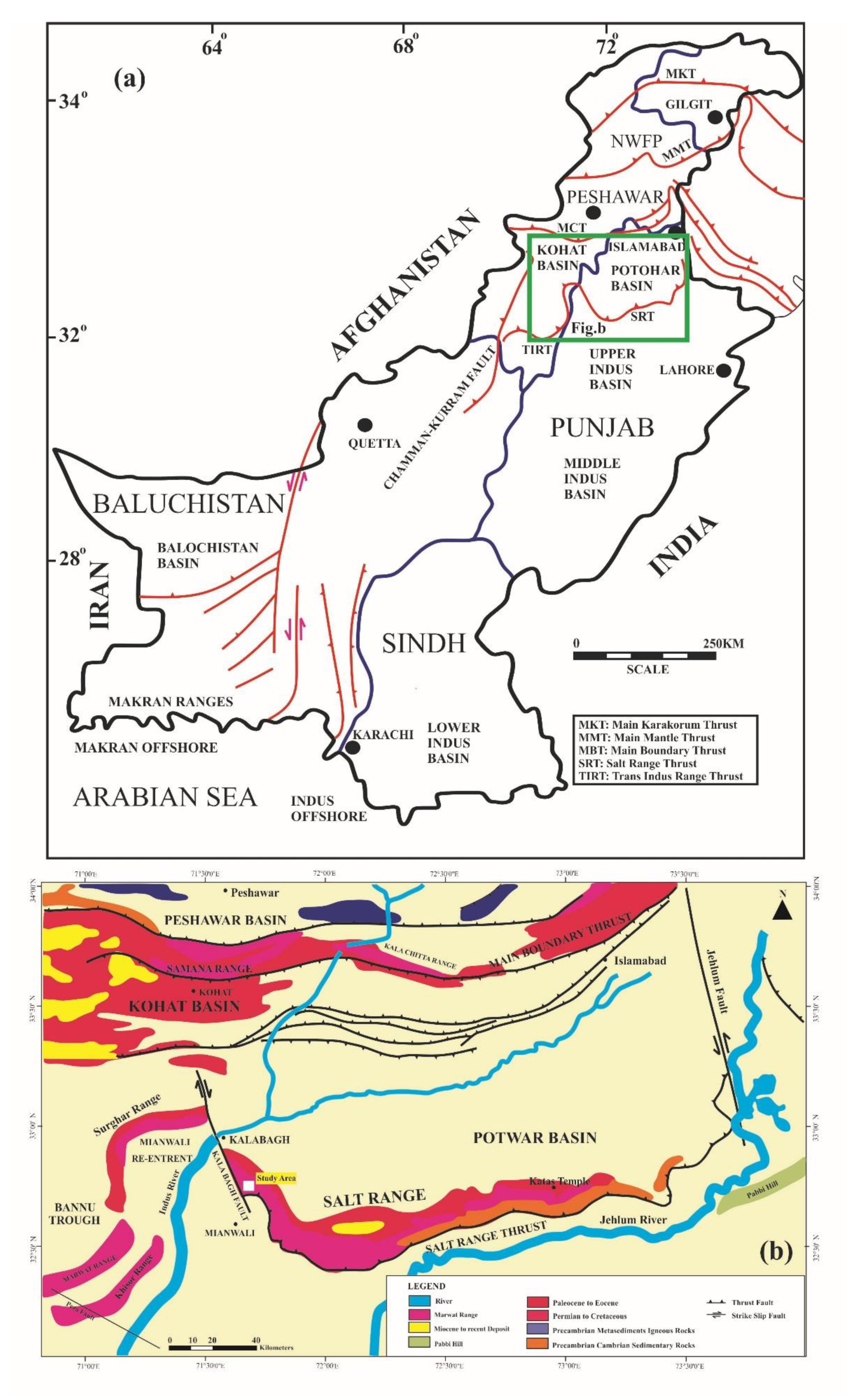
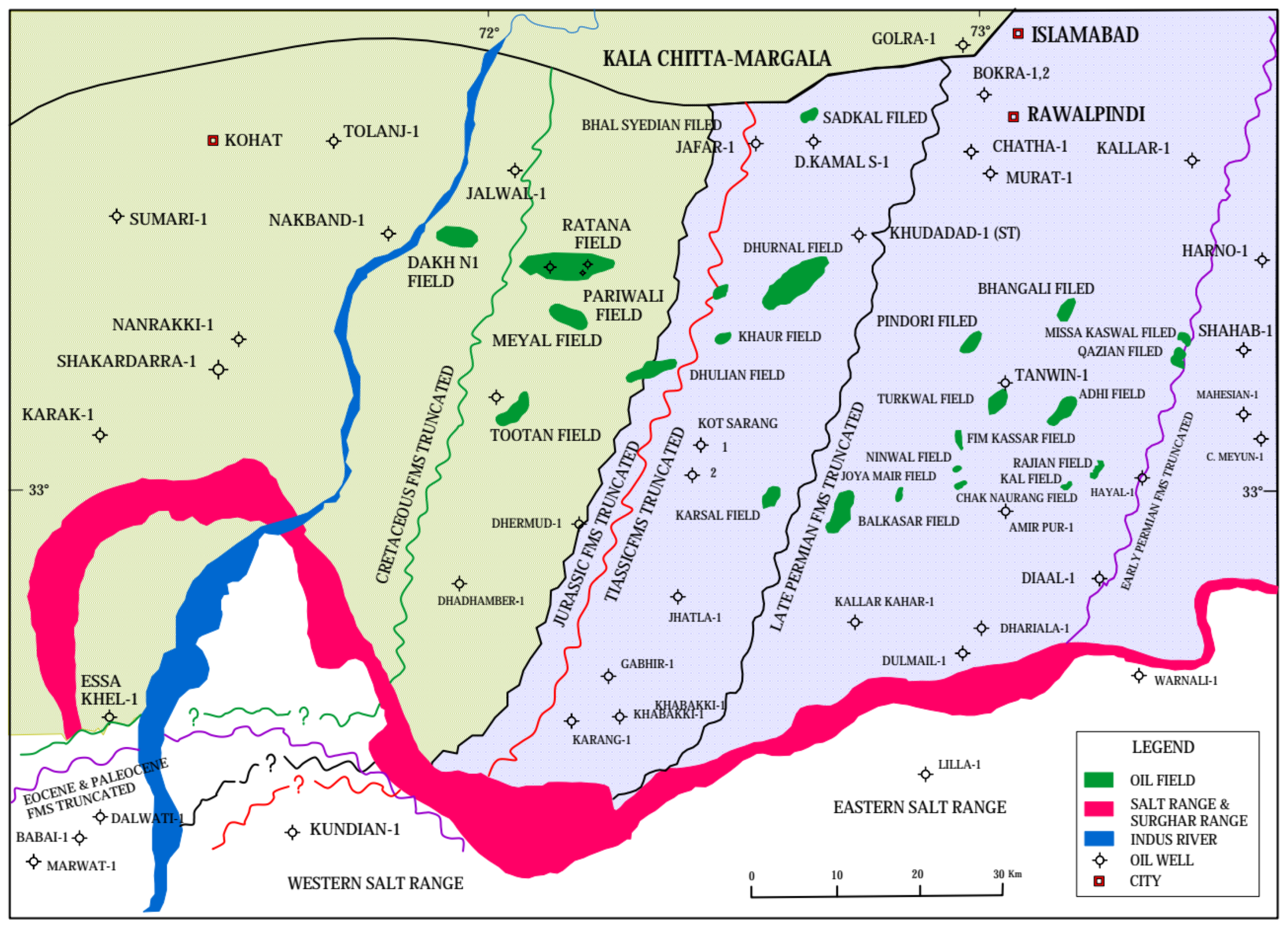
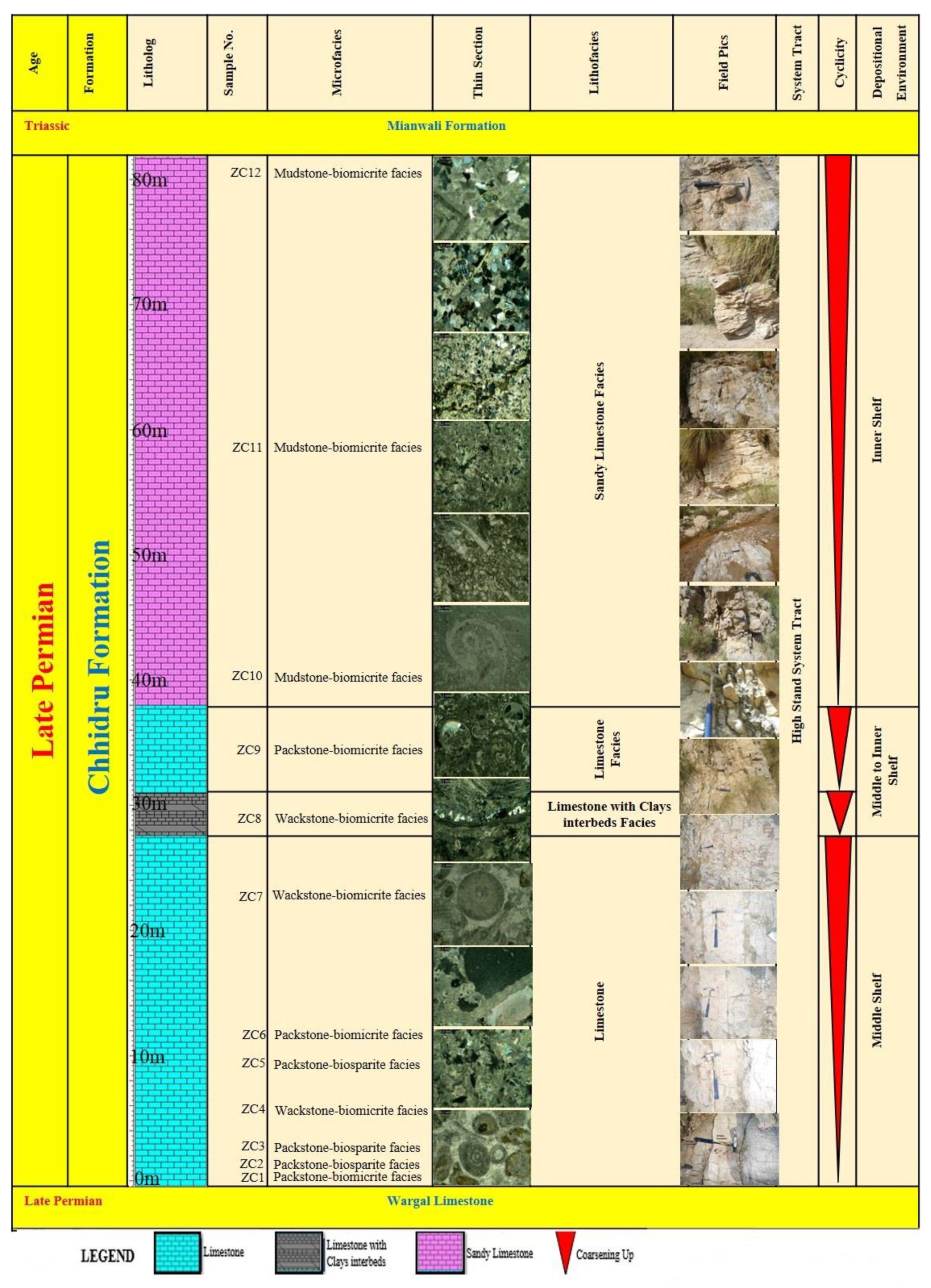
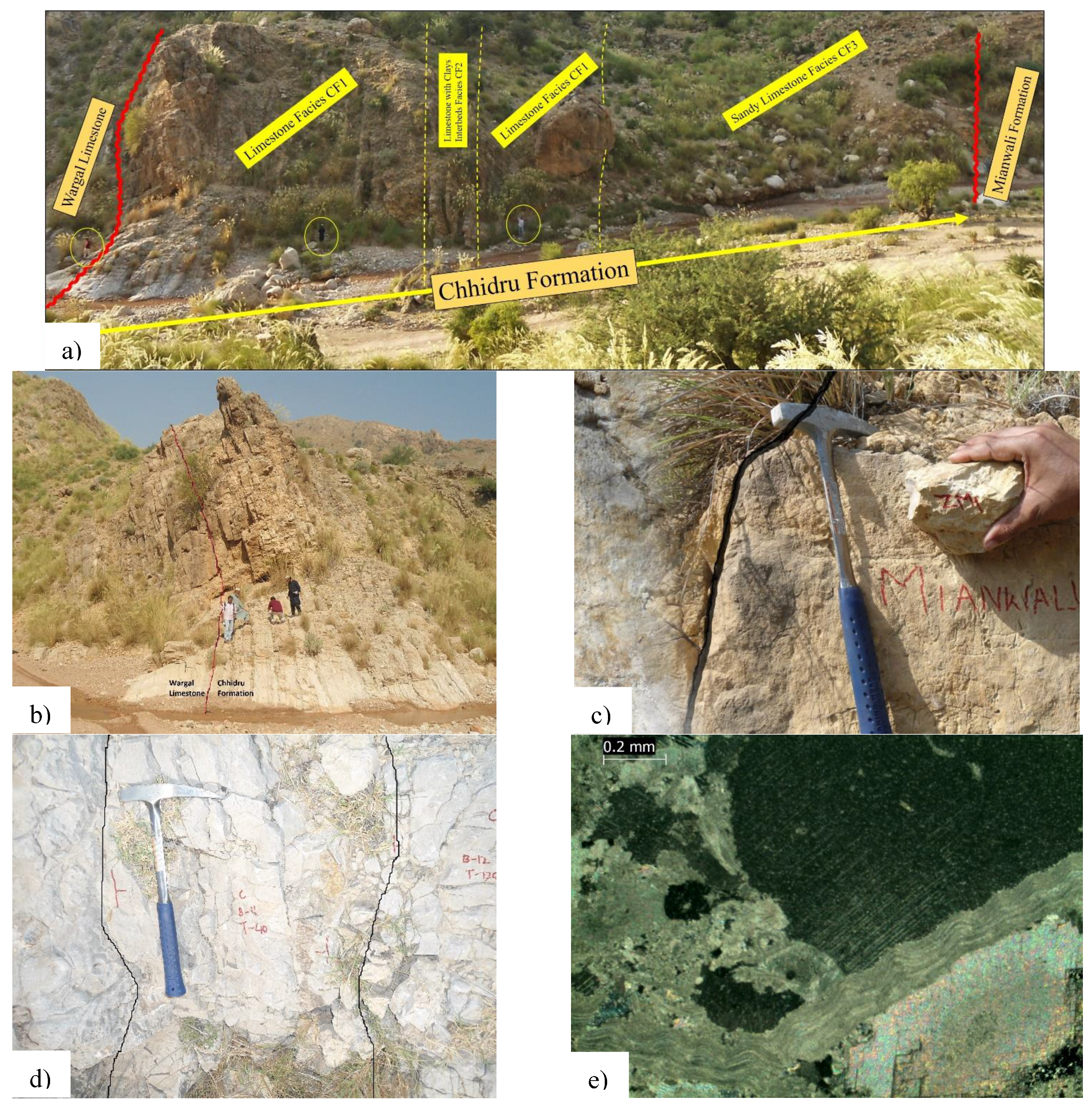
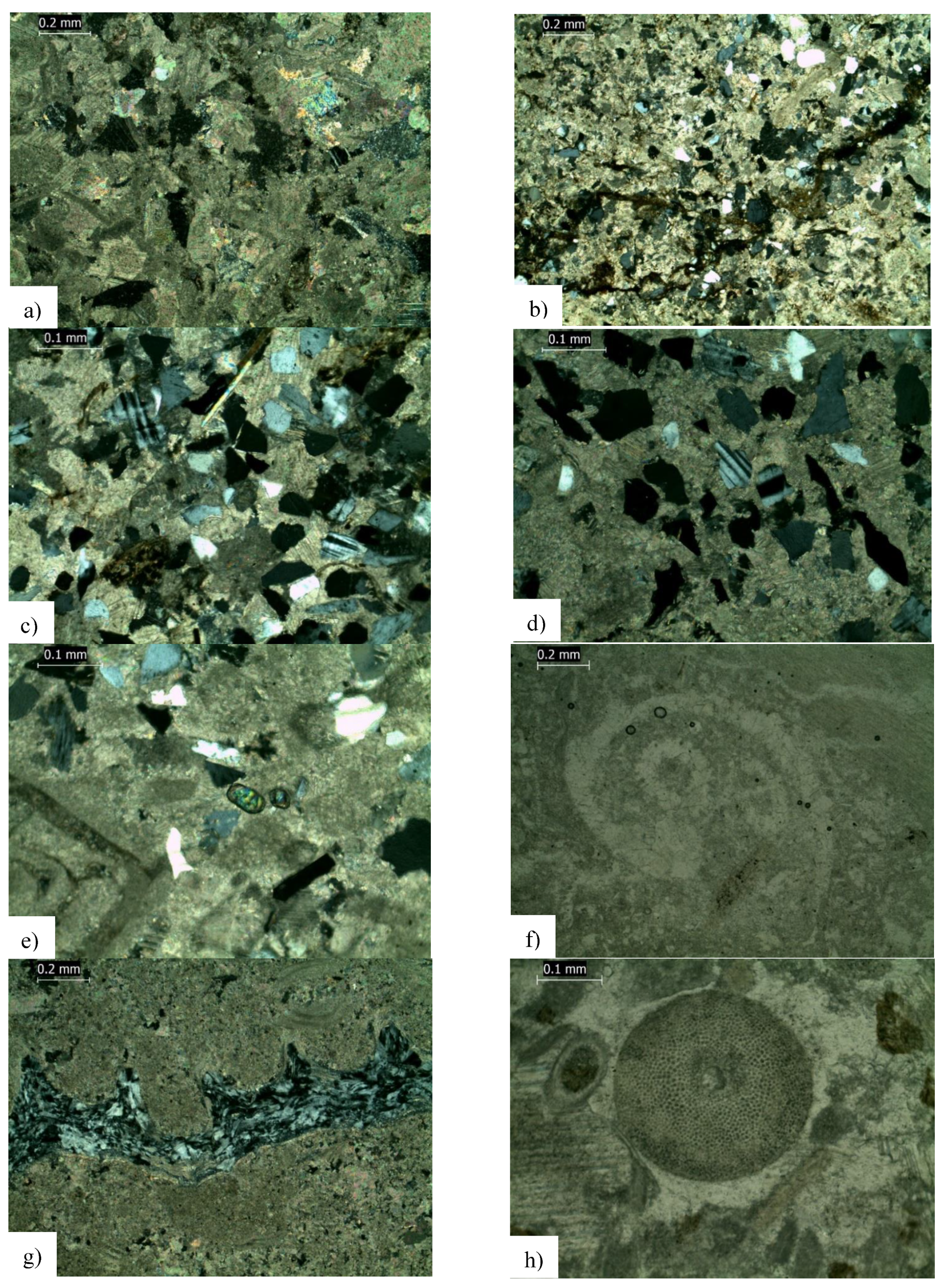
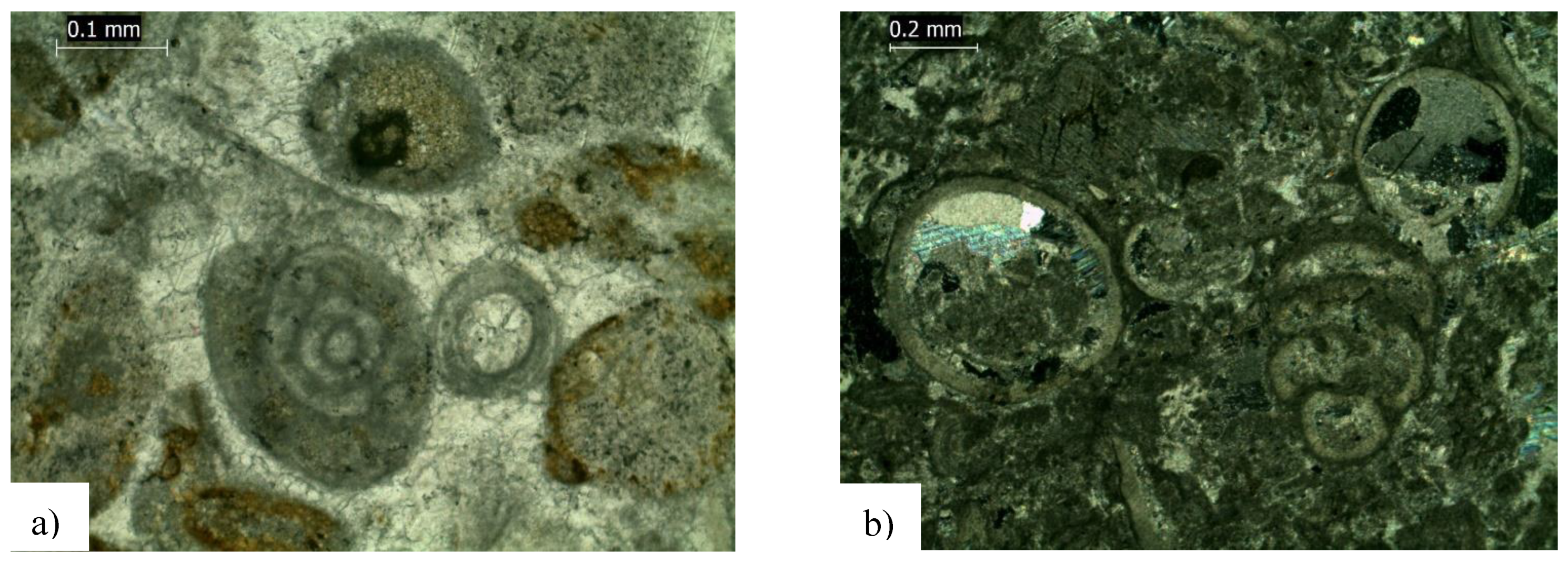
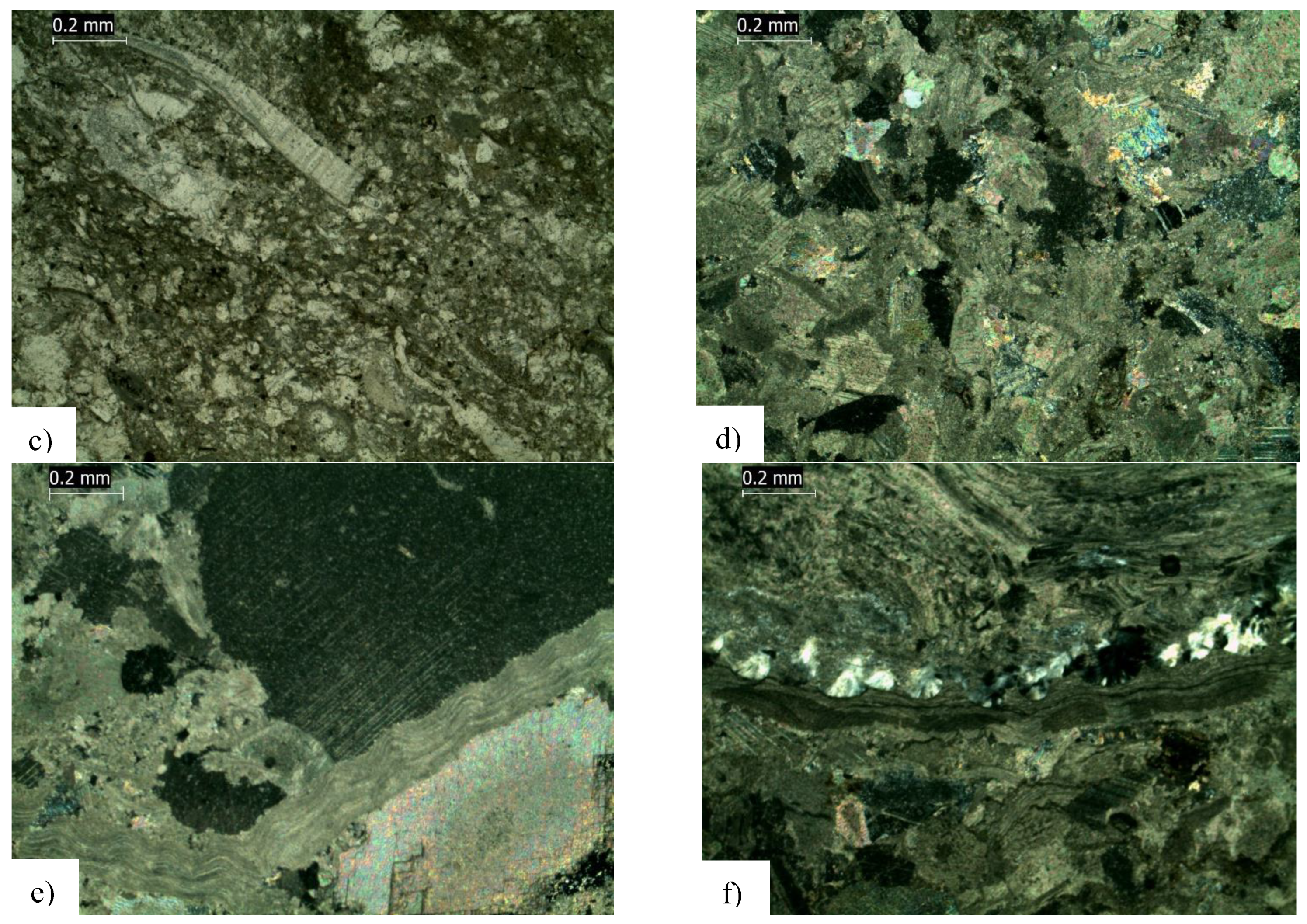

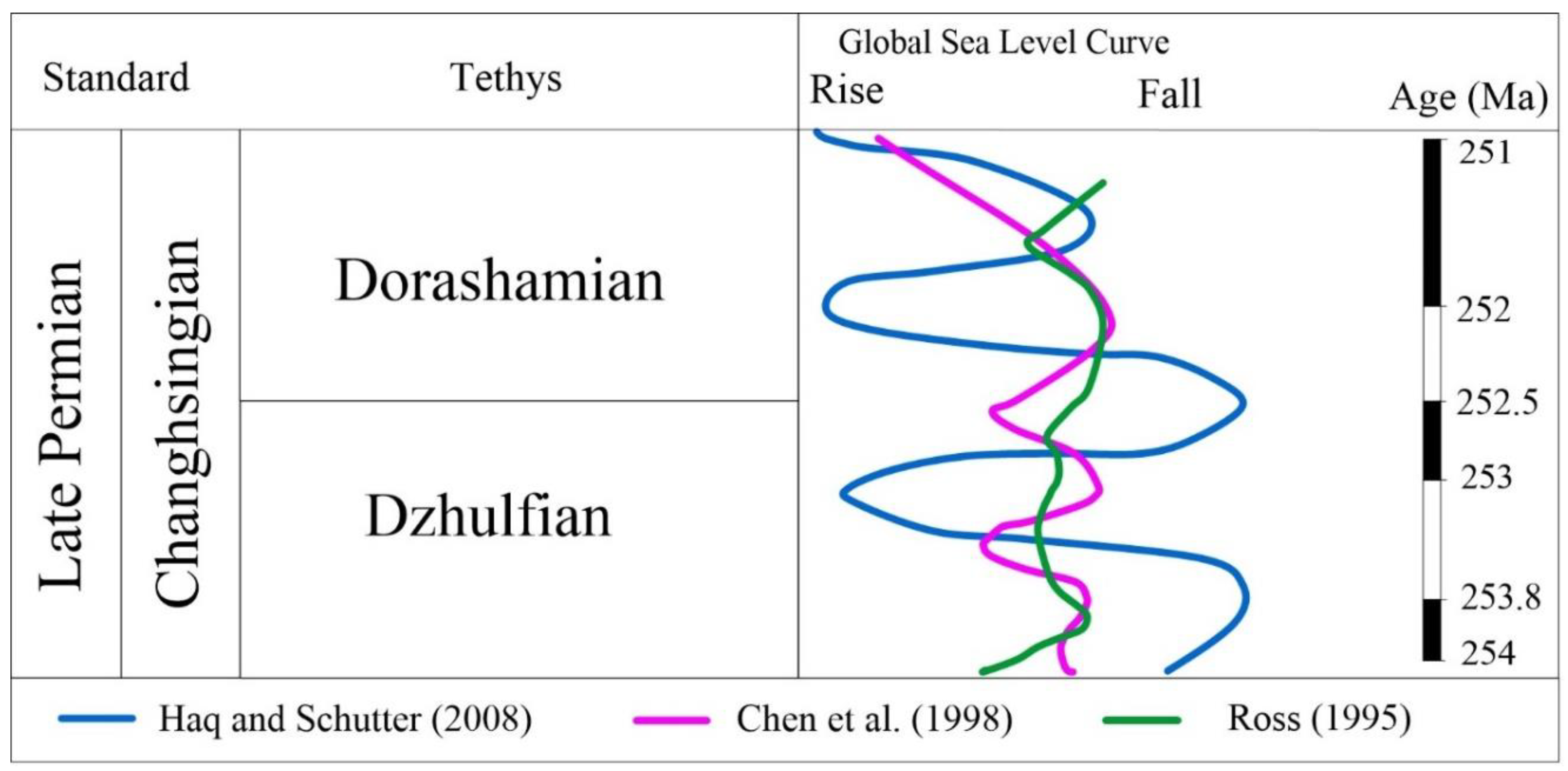
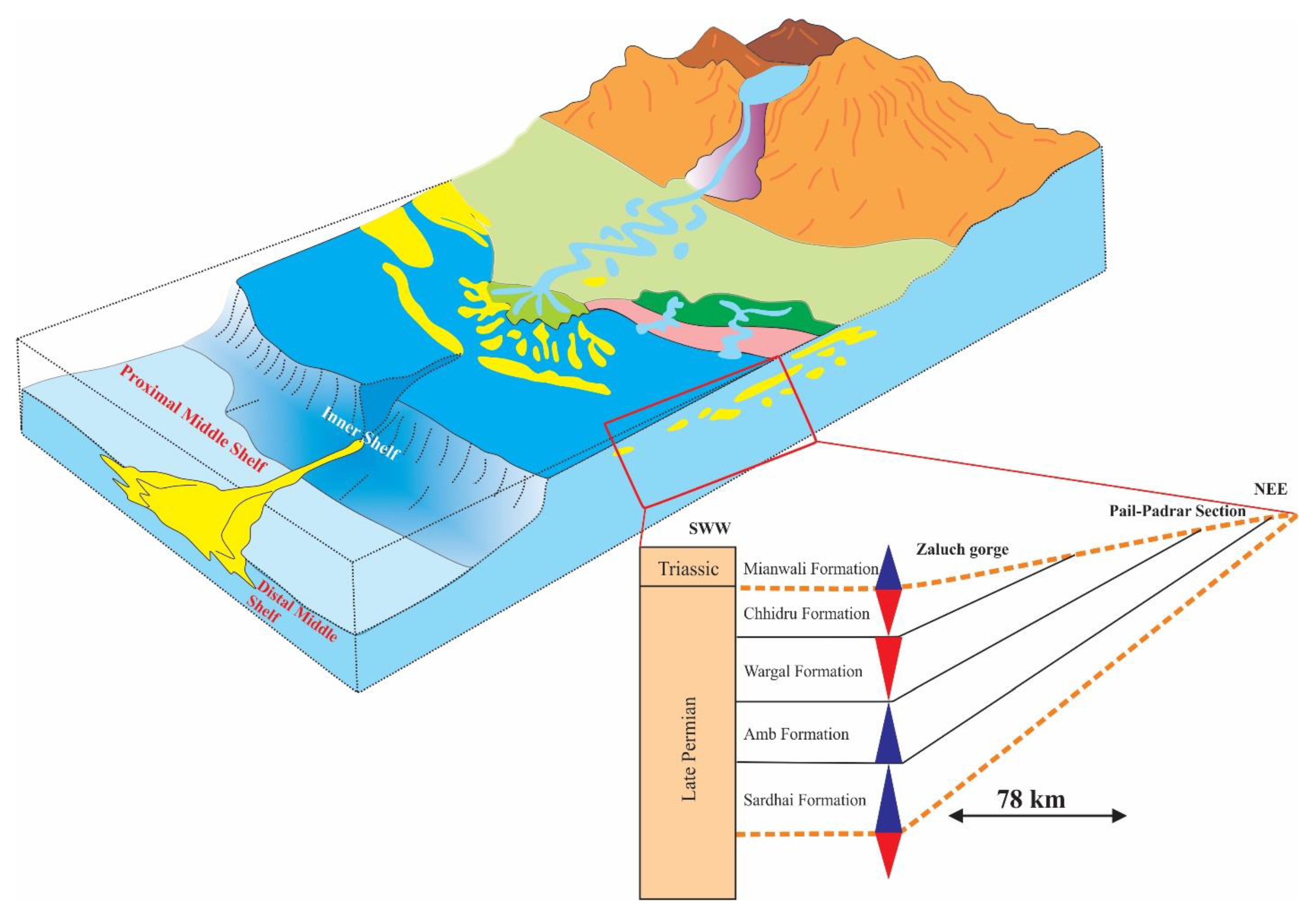
| Formation | Lithology | Age |
|---|---|---|
| Datta Formation | Sandstone, Siltstone, Glass sand, Fire clay | Jurassic |
| Kingriali Formation | Dolomite, Limestone, Marl, Shale | Triassic |
| Tredian Formation | Sandstone, Shale | Middle Triassic |
| Mianwali Formation | Sandstone, Shale, Dolomite (Heterogeneous lithology) | Lower Triassic |
| Unconformity (P-T Boundary) | ||
| Chhidru Formation | Limestone, Sandstone | Late Permian |
| Wargal Limestone | Limestone, Dolomite | Late Permian |
| Amb Formation | Shale, Limestone | Middle to Late Permian |
| Unconformity | ||
| Sardhai Formation | Shale | Early Permian |
| Warchha Sandstone | Sandstone | Early Permian |
| Tobra Formation | Conglomerates having tillitic, fresh water and complex facies | Early Permian |
| Unconformity | ||
| Salt Range Formation | Salt, Marl, Gypsum | Precambrian |
| Sample No. | Quartz % | Feldspar % | Calcite % | Bioclasts % | Others % | Classification | |
|---|---|---|---|---|---|---|---|
| Dunham [73] | Folk [96] | ||||||
| ZC12 | 29 | 5 | 63 | 2 | Muscovite 1%, Zircon (Trace) | Mudstone | Biomicrite |
| ZC11 | 63 | 4 | 28 | 1 | Hematite 1%, Muscovite 3% | Mudstone | Biomicrite |
| ZC10 | 41 | 4 | 51 | 2 | Hematite 2%, Muscovite (Trace) | Mudstone | Biomicrite |
| Bioclasts | Micrite | Spar | |||||
| ZC9 | 31 | 43 | 26 | ------ | Packstone | Biomicrite | |
| ZC8 | 19 | 77 | 10 | ------ | Wackstone | Biomicrite | |
| ZC7 | 19 | 61 | 20 | ------ | Wackstone | Biomicrite | |
| ZC6 | 73 | 18 | 9 | ------ | Packstone | Biomicrite | |
| ZC5 | 14 | 36 | 50 | ------ | Packstone | Biosparite | |
| ZC4 | 49 | 16 | 35 | Hematite (Trace) | Wackstone | Biosparite | |
| ZC3 | 55 | 9 | 36 | ------ | Packstone | Biosparite | |
| ZC2 | 43 | 14 | 37 | Hematite 1% | Packstone | Biosparite | |
| ZC1 | 51 | 19 | 11 | Hematite 5% | Packstone | Biomicrite | |
Publisher’s Note: MDPI stays neutral with regard to jurisdictional claims in published maps and institutional affiliations. |
© 2021 by the authors. Licensee MDPI, Basel, Switzerland. This article is an open access article distributed under the terms and conditions of the Creative Commons Attribution (CC BY) license (https://creativecommons.org/licenses/by/4.0/).
Share and Cite
Ali, S.K.; Janjuhah, H.T.; Shahzad, S.M.; Kontakiotis, G.; Saleem, M.H.; Khan, U.; Zarkogiannis, S.D.; Makri, P.; Antonarakou, A. Depositional Sedimentary Facies, Stratigraphic Control, Paleoecological Constraints, and Paleogeographic Reconstruction of Late Permian Chhidru Formation (Western Salt Range, Pakistan). J. Mar. Sci. Eng. 2021, 9, 1372. https://doi.org/10.3390/jmse9121372
Ali SK, Janjuhah HT, Shahzad SM, Kontakiotis G, Saleem MH, Khan U, Zarkogiannis SD, Makri P, Antonarakou A. Depositional Sedimentary Facies, Stratigraphic Control, Paleoecological Constraints, and Paleogeographic Reconstruction of Late Permian Chhidru Formation (Western Salt Range, Pakistan). Journal of Marine Science and Engineering. 2021; 9(12):1372. https://doi.org/10.3390/jmse9121372
Chicago/Turabian StyleAli, Syed Kamran, Hammad Tariq Janjuhah, Syed Muzyan Shahzad, George Kontakiotis, Muhammad Hussain Saleem, Usman Khan, Stergios D. Zarkogiannis, Panayota Makri, and Assimina Antonarakou. 2021. "Depositional Sedimentary Facies, Stratigraphic Control, Paleoecological Constraints, and Paleogeographic Reconstruction of Late Permian Chhidru Formation (Western Salt Range, Pakistan)" Journal of Marine Science and Engineering 9, no. 12: 1372. https://doi.org/10.3390/jmse9121372
APA StyleAli, S. K., Janjuhah, H. T., Shahzad, S. M., Kontakiotis, G., Saleem, M. H., Khan, U., Zarkogiannis, S. D., Makri, P., & Antonarakou, A. (2021). Depositional Sedimentary Facies, Stratigraphic Control, Paleoecological Constraints, and Paleogeographic Reconstruction of Late Permian Chhidru Formation (Western Salt Range, Pakistan). Journal of Marine Science and Engineering, 9(12), 1372. https://doi.org/10.3390/jmse9121372










